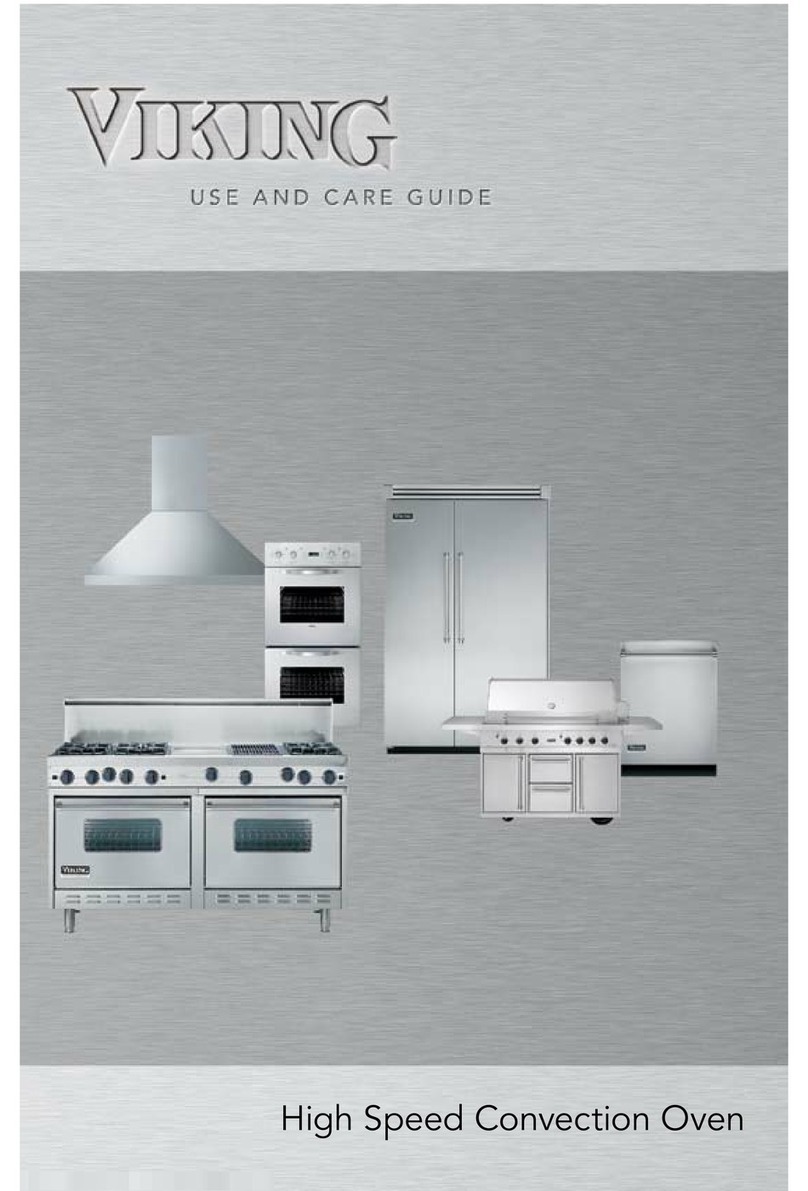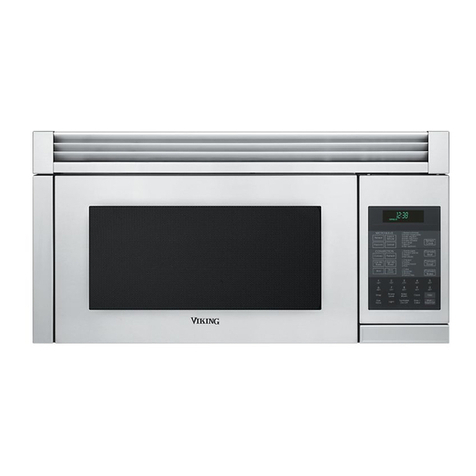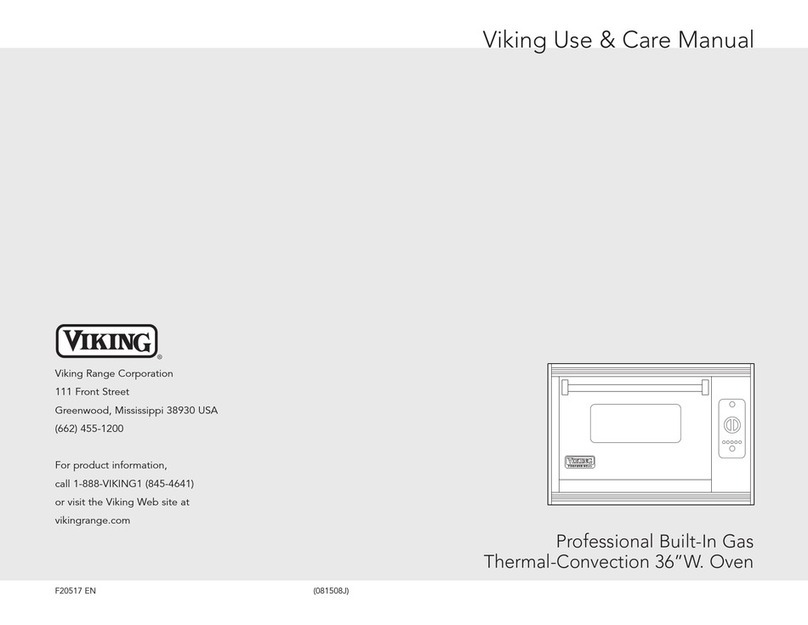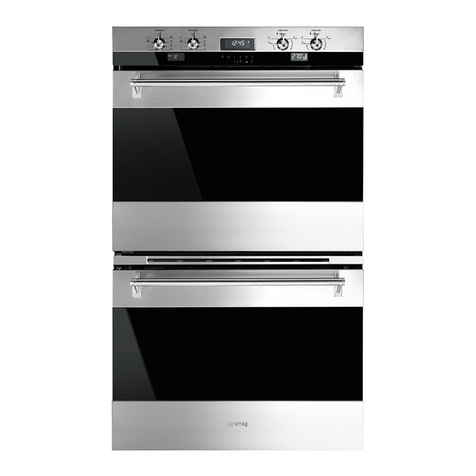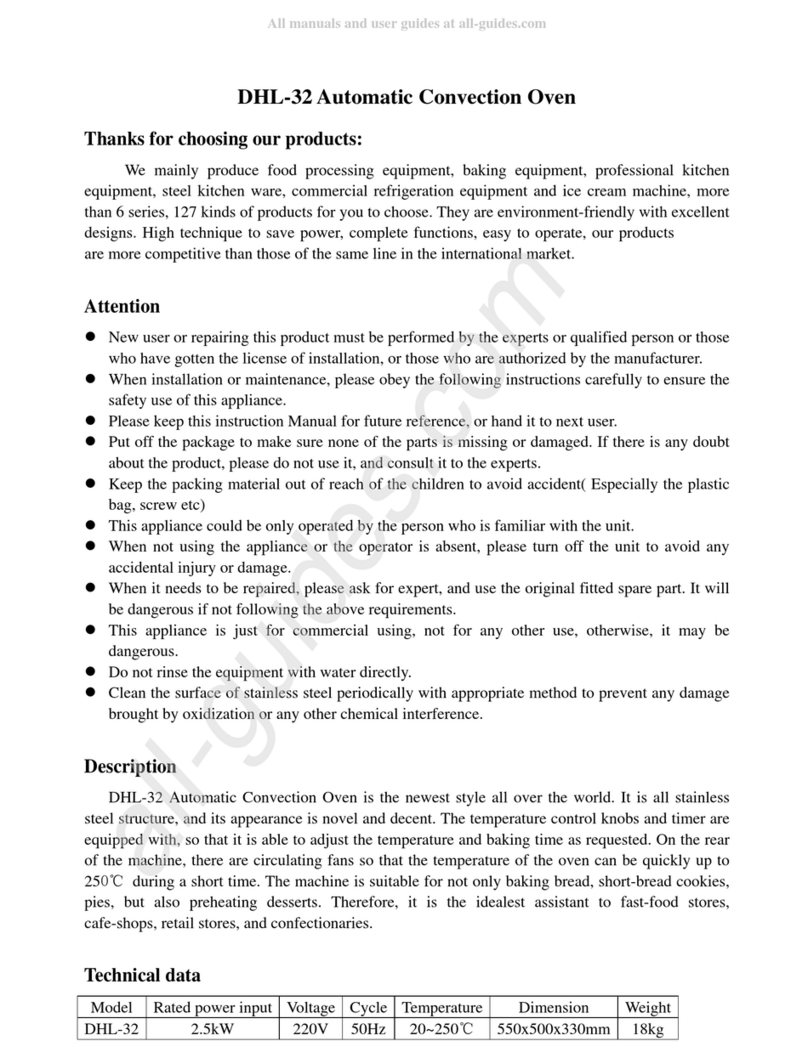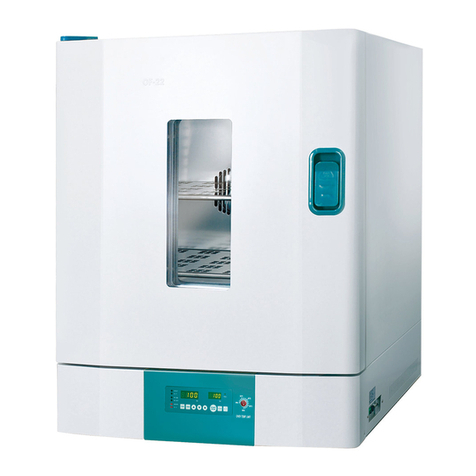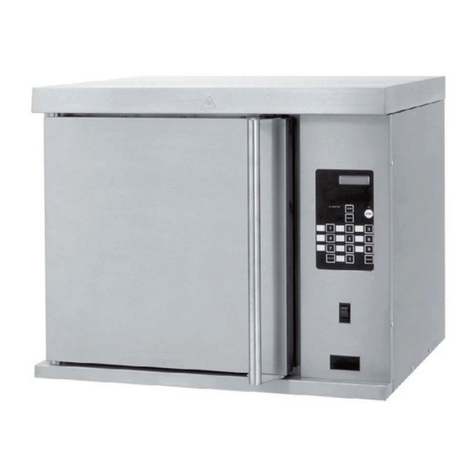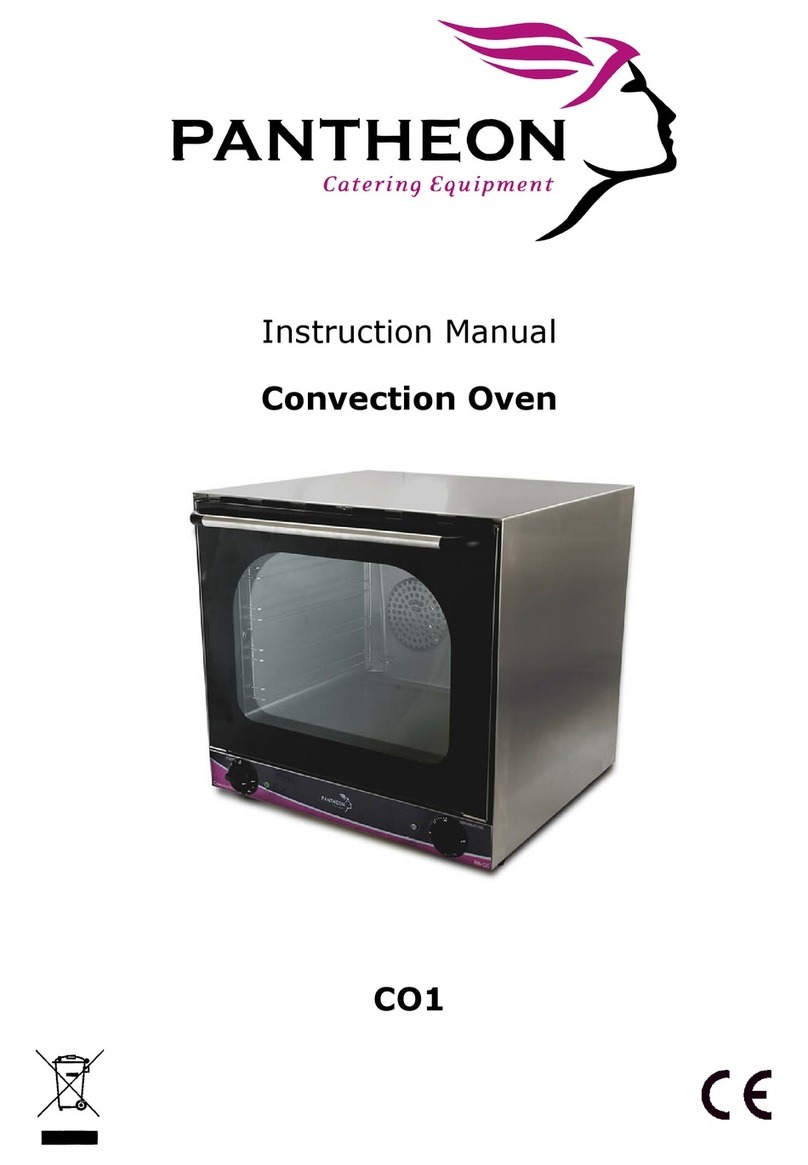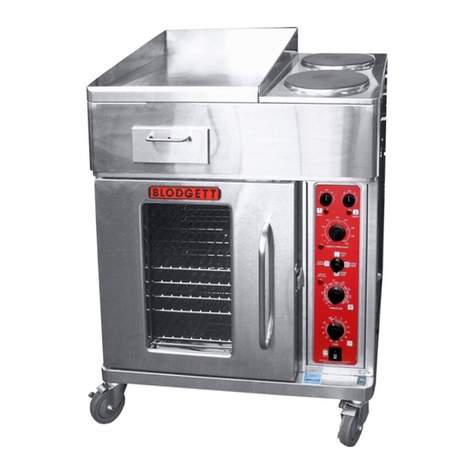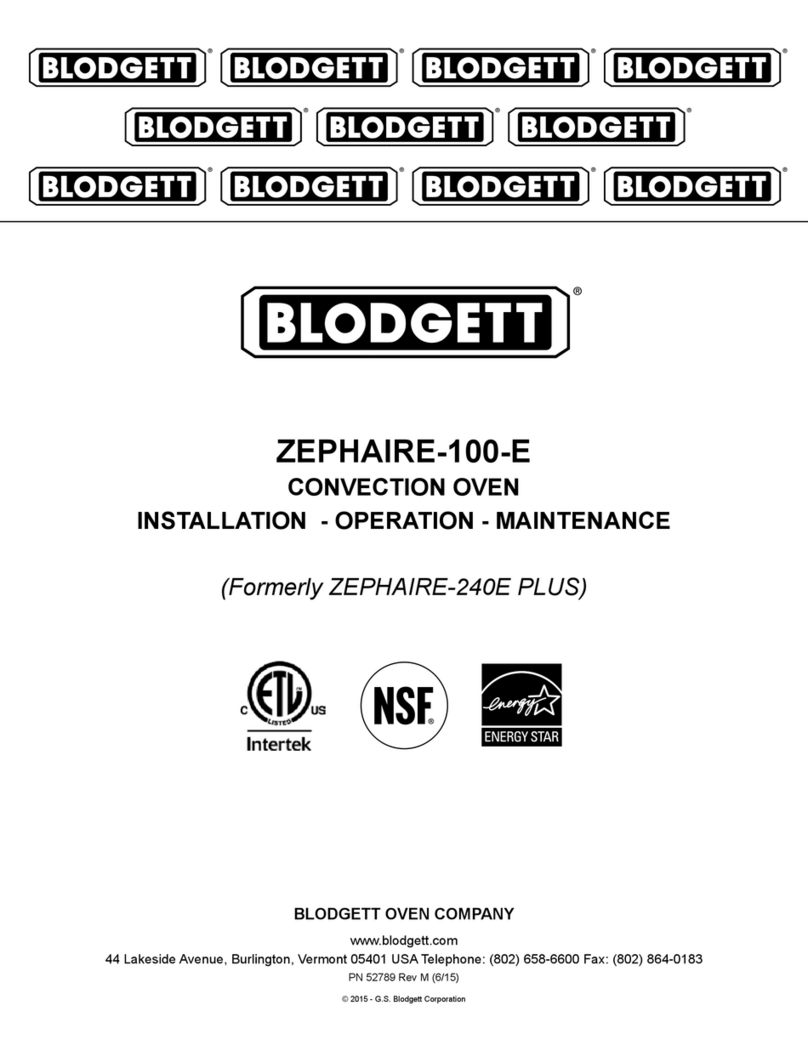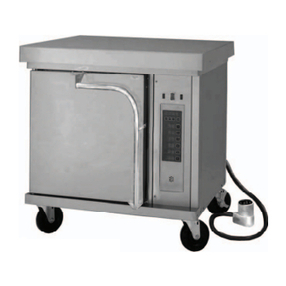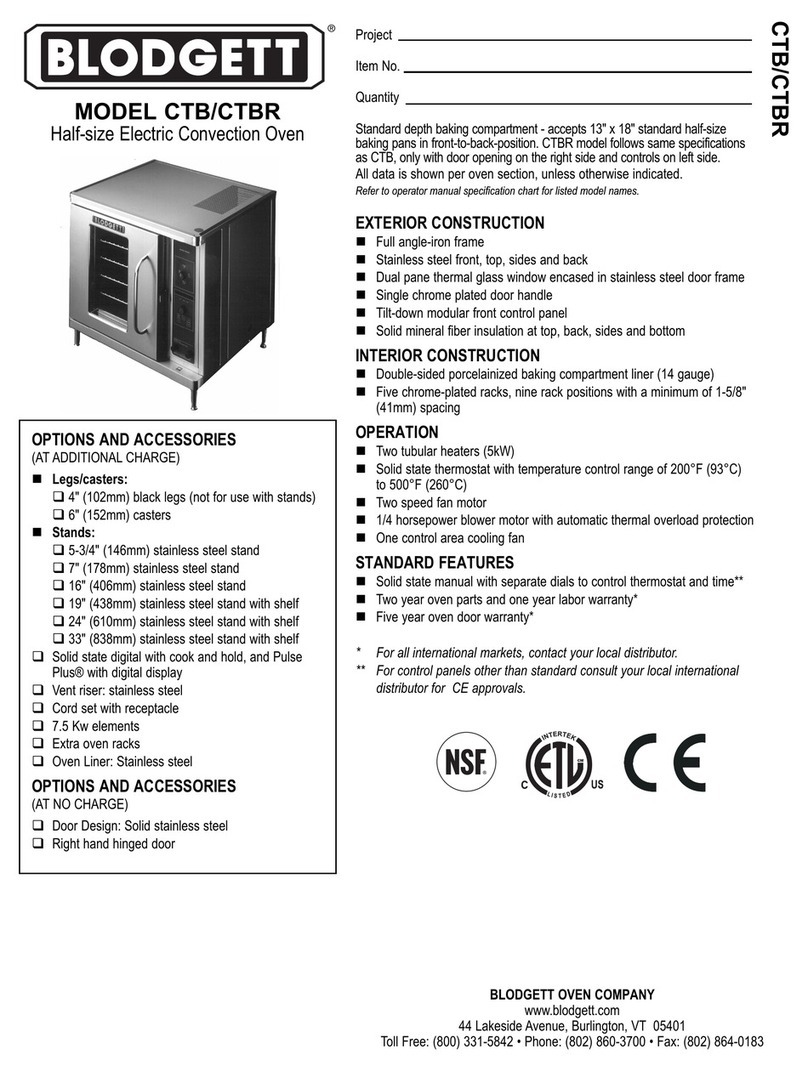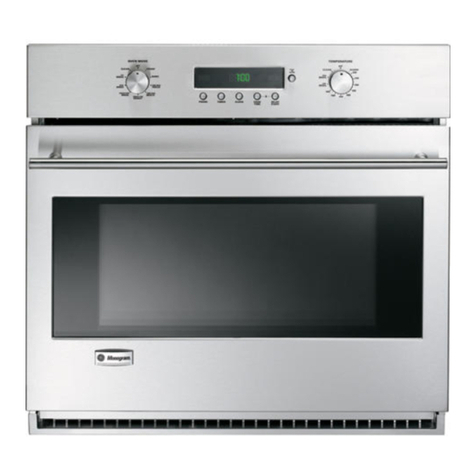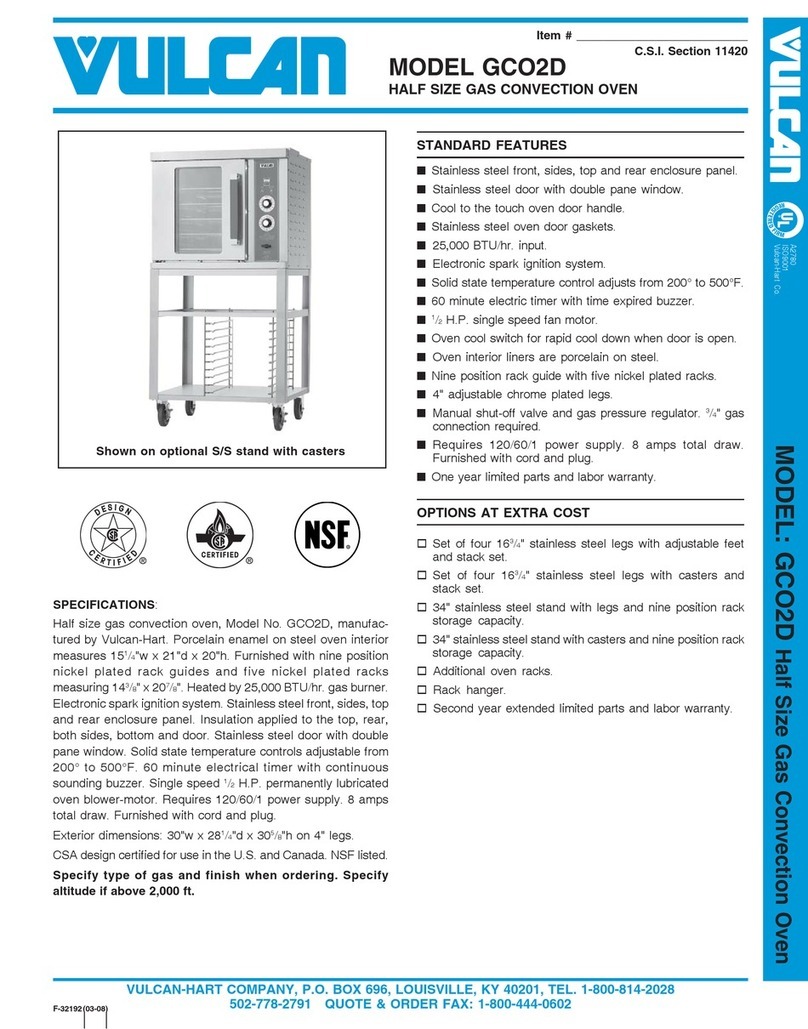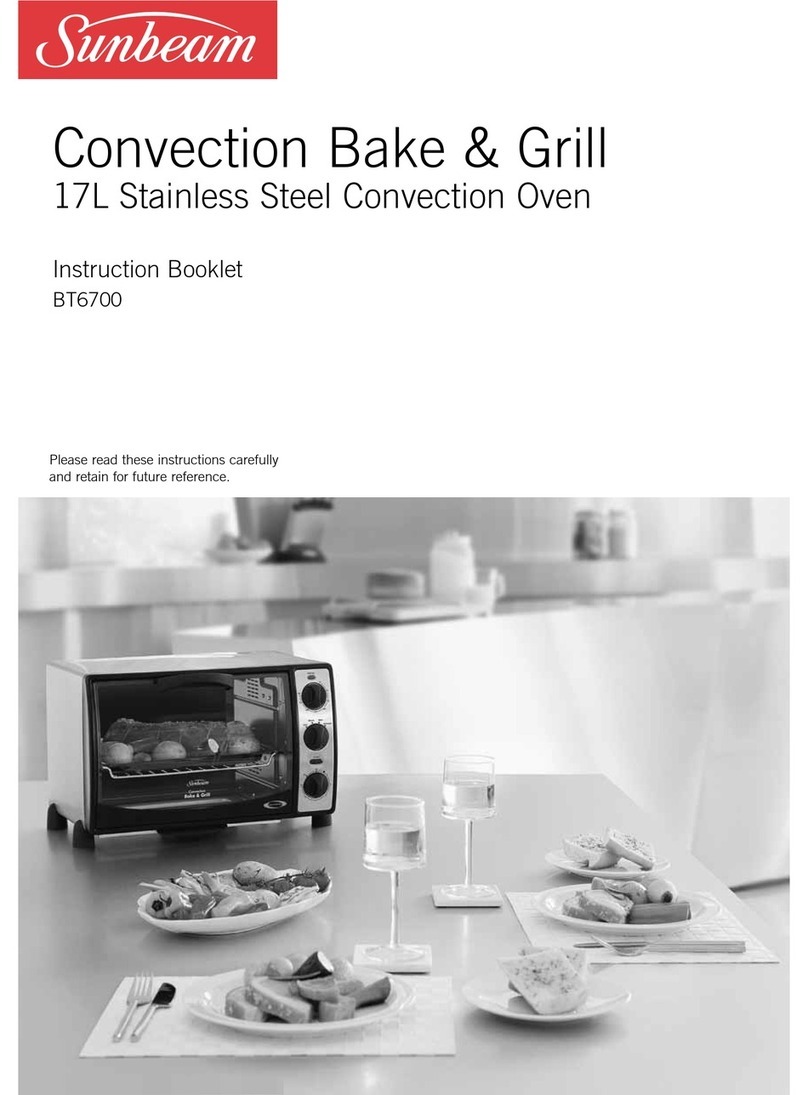Viking VCSO210SS User manual

Viking Use & Care Manual
Combi Steam/Convect™Oven

E
Congratulations and welcome to the elite world of Viking
ownership. We hope you will enjoy and appreciate the care
and attention we have put into every detail of your new,
state-of-the-art Combi Steam/Convect™ Oven.
Your Viking Combi Steam/Convect™ Oven is designed to offer
years of reliable service. This Use and Care Guide will provide
you with the information you need to become familiar with your
Combi Steam/Convect™ Oven’s care and operation.
Your complete satisfaction is our ultimate goal. If you have
any questions or comments about this product, please contact
the dealer from whom you purchased it, or contact our
Consumer Support Center at 1-888-VIKING1.
We appreciate your choice of a Viking Combi Steam/Convect™
Oven and hope that you will again select our products for your
other major appliance product needs.
For more information about the complete and growing selection
of Viking products, contact your dealer or visit us online at
vikingrange.com.
Congratulations

E
Getting Started _______________________________ 3
Warnings__________________________________3-4
Important Safety Instructions_________________5-7
Important–Please Read And Follow__________8-24
About Unpacking and Examining Your Oven _ 8
Choosing a Location for Your Oven _________ 8
Ordering a Built-In Kit _____________________ 9
Electrical Grounding Instructions____________ 9
Extension Cord __________________________ 10
Radio or TV Interference__________________ 10
About Your Combi Steam/Convect™ Oven _ 10
About Cooking Options __________________ 11
About Steam Convection and Steam Cooking11
About Microwave Cooking________________ 14
About Food When Using
The Microwave Mode ____________________ 15
About Utensils and Coverings _____________ 17
About Children __________________________ 21
About Safety ____________________________ 21
Product Control______________________________ 25
Part Names_____________________________ 25-26
Control Panel ___________________________ 26
Display Information ______________________ 26
Important Instructions____________________ 27-31
Reservoir _______________________________ 27
Drip Tray _______________________________ 28
Steam Convection & Steam in
Automatic and Manual Cooking ___________ 29
Drain Water Function_____________________ 29
Descale Function ________________________ 30
Operation ___________________________________ 32
Before Operating _______________________ 32-33
To Set The Clock ________________________ 32
Stop/Clear ______________________________ 32
Back ___________________________________ 33
Clean The Oven Before First Use _____________ 33
Automatic Cooking______________________ 34-53
Steam Convection _______________________ 34
Steam __________________________________ 43
Table of Contents

E
Microwave ______________________________ 45
Defrost _________________________________ 52
Manual Cooking ________________________ 54-64
Cooking Time Input______________________ 55
Steam Convection _______________________ 55
Convection _____________________________ 58
Steam __________________________________ 60
Microwave ______________________________ 62
Manual Defrost __________________________ 64
Other Convenient Features _______________ 65-70
Automatic Cooking Time Adjustment
(More Or Less Time Adjustment) ___________ 65
Extending Cooking Time
At The End Of Cooking___________________ 65
Temperature Adjustment _________________ 66
End Of Cooking Reminder ________________ 66
Multiple Sequence Cooking_______________ 66
Info ____________________________________ 68
Product Care _____________________________ 71-80
Cleaning And Care ______________________ 71-73
Oven Cleaning - Exterior _________________ 71
Door __________________________________ 71
Control Panel ___________________________ 71
Oven Cleaning - Interior __________________ 72
Door Gasket ____________________________ 72
Baking Tray / High Rack /
Low Rack / Steam Basket _________________ 73
Reservoir And Reservoir Lid _______________ 73
Drip Tray And Drip Tray Lid _______________ 73
Descaling Within The Oven’s Steam Parts __ 73
Troubleshooting Chart ___________________ 74-78
Service Call Check__________________________ 79
Specifications ______________________________ 80
Combi Steam/Convect™ Oven Warranty ______ 81
Table of Contents

E
Getting Started
3
Warnings
Warning and Important Safety Instructions appearing in this
manual are not meant to cover all possible conditions and
situations that may occur. Common sense, caution, and care
must be exercised when installing, maintaining, or operating
this appliance.
ALWAYS contact the manufacturer about problems or conditions you
do not understand.
Recognize Safety Symbols, Words, Labels
DANGER
Hazards or unsafe practices which WILL result in
severe personal injury or death
WARNING
Hazards or unsafe practices which COULD
result in death or severe personal injury
WARNING
Hazards or unsafe practices which COULD result
in minor personal injury or property damage.
All safety messages will identify the hazard, tell you how to reduce
the chance of injury, and tell you what can happen if the instructions
are not followed.
Read and follow all instructions before using this appliance
to prevent the potential risk of fire, electric shock, personal injury
or damage to the appliance as a result of improper usage of the
appliance. Use appliance only for its intended purpose as described in
this manual.
To ensure proper and safe operation: Appliance must be properly
installed and grounded by a qualified technician. DO NOT attempt to
adjust, repair, service, or replace any part of your appliance unless it is
specifically recommended in this manual. All other servicing should be
referred to a qualified servicer.

E
Getting Started
4
WARNING
Improper use of the grounding plug can result in a risk
of electric shock.
PRECAUTIONS TO AVOID
POSSIBLE EXPOSURE
TO EXCESSIVE
MICROWAVE ENERGY
(a) Do not attempt to operate this oven with the door open
since open-door operation can result in harmful exposure to
microwave energy. It is important not to defeat or tamper
with the safety interlocks.
(b) Do not place any object between the oven front face and
the door or allow soil or cleaner residue to accumulate on
sealing surfaces.
(c) Do not operate the oven if it is damaged. It is particularly
important that the oven door close properly and that there
is no damage to the: (1) door (bent), (2) hinges and latches
(broken or loosened), (3) door seals and sealing surfaces.
(d) The oven should not be adjusted or repaired by anyone
except properly qualified service personnel.
Warnings

E
Getting Started
When using electrical appliances basic safety precautions should
be followed, including the following:
WARNING - To reduce the risk of burns, electric shock, fire, injury
to persons or exposure to excessive microwave energy:
• Readallinstructionsbeforeusingtheappliance.
• Readandfollowthespecic“PRECAUTIONSTOAVOIDPOS-
SIBLE EXPOSURE TO EXCESSIVE MICROWAVE ENERGY” on
page 4.
• This appliance must be properly grounded. Connect only
to properly grounded outlet. See Grounding Instructions on
page 9-10.
• Installorlocatethisapplianceonlyinaccordancewiththepro-
vided Installation Manual.
• Someproductssuchaswholeeggsandsealedcontainers-for
example, closed glass jars—are able to explode and should not
be heated in the appliance.
• Usethisapplianceonlyforitsintendeduseasdescribedinthis
manual. Do not use corrosive chemicals or vapors in this appli-
ance. This appliance is specifically designed to heat, cook or
dry food. It is not designed for industrial or laboratory use.
• Aswithanyappliance,closesupervisionisnecessarywhenused
by children.
• Donotoperatethisapplianceifithasadamagedcordorplug,if
it is not working properly or if it has been damaged or dropped.
• This appliance should be serviced only by qualied service
personnel. Contact nearest Viking Authorized Servicer for ex-
amination, repair or adjustment.
• Donotcoverorblockanyopeningsontheappliance.
• Donotstoreorusethisapplianceoutdoors.Donotusethis
product near water—for example, near a kitchen sink, in a wet
basement, near a swimming pool or similar locations.
• Donotimmersecordorpluginwater.
• Keepcordawayfromheatedsurfaces.
• Donotletcordhangoveredgeoftableorcounter.
• Seedoorsurfacecleaninginstructionsonpage71.
5
IMPORTANT SAFETY
INSTRUCTIONS

E
Getting Started
• Toreducetheriskofreintheappliancecavity:
- Do not overcook food. Carefully attend appliance when
paper, plastic or other combustible materials are placed
inside the appliance to facilitate cooking.
- Remove wire twist-ties from paper or plastic bags before
placing bag in appliance.
- If materials inside the appliance ignite, keep appliance door
closed, turn microwave off and shut off power at the fuse
or circuit breaker panel.
- Do not use the appliance for storage purposes. Do not leave
paper products, cooking utensils, or food in the appliance
when not in use.
• Liquids,suchaswater,coffeeorteaareabletobeoverheated
beyond the boiling point without appearing to be boiling due to
surface tension of the liquid. Visible bubbling or boiling when the
container is removed from the appliance is not always present.
THIS COULD RESULT IN VERY HOT LIQUIDS SUDDENLY
BOILING OVER WHEN A SPOON OR OTHER UTENSIL IS
INSERTED INTO THE LIQUID.
To reduce the risk of injury to persons:
- Do not overheat the liquid.
- Stir the liquid both before and halfway through heating it.
- Do not use straight-sided containers with narrow necks. Use
a wide-mouthed container.
- After heating, allow the container to stand in the appliance
at least for 20 seconds before removing the container.
- Use extreme care when inserting a spoon or other utensil
into the container.
• If the appliance light fails, consult a VIKING AUTHORIZED
SERVICER.
• Donotoperateanyheatingorcookingappliancebeneaththis
appliance, except a properly installed electric wall oven or a
warming drawer.
IMPORTANT SAFETY
INSTRUCTIONS
6

E
Getting Started
IMPORTANT SAFETY
INSTRUCTIONS
• Donotmountunitoverornearanyportionofaheatingorcook-
ing appliance, except a properly installed electric wall oven or
a warming drawer.
• Donotmountoversink.
• Donotstoreanythingdirectlyontopoftheappliancesurface
when the appliance is in operation.
SAVE THESE INSTRUCTIONS
7

E
Getting Started
ABOUT UNPACKING
AND EXAMINING
YOUR OVEN
Remove all packing materials
from inside the oven cavity. Read
enclosures and SAVE this Use and
Care Guide.
Check the oven for any damage,
such as misaligned or bent door,
damaged door seals and sealing
surfaces, broken or loose door
hinges and latches and dents inside
the cavity or on the door. If there is
any damage, do not operate the oven and contact your dealer or
a VIKING AUTHORIZED SERVICER.
CHOOSING A LOCATION FOR YOUR
OVEN
You will use your oven frequently so plan its location for ease of
use. Do not place the oven on a mat, carpet or tablecloth or block
the ventilation openings. The oven must be placed on a countertop
which is a minimum of 36
inches (91.5 cm) from the
floor. Allow at least 2 inches
(5.1 cm) on the sides, and
2 inches (5.1 cm) above the
top of the oven (excluding
the air vent opening) for
air circulation. Be sure to
position oven so that the
rear cannot be touched
inadvertently.
Your Combi Steam/Con-
vect™ Oven can be built
into a cabinet or wall by
itself, or above any electric
wall oven, above warming drawer, above Drawer Microwave. It
cannot be built in above any gas wall oven.
Refer to Illustration 1 for proper location when building in above
Oven Cavity
Hinges Latches
Door Seals and
Sealing Surfaces
Min. 2"
(5.1 cm)
Min. 36"
(91.5 cm)
Illustration 1
Combi Steam/
Convect™
Oven cutout
Electric wall
oven /
Warming
Drawer /
Drawer Micro-
wave cutout
IMPORTANT– Please Read and Follow
8

E
Getting Started
an electric wall oven, a warming drawer or Drawer Microwave.
Carefully follow both the electric wall oven/warming drawer/
microwave drawer installation instructions and Viking’s Built-in Kit
instructions. Be sure that the clearance of the floor between the
Combi Steam/Convect™ Oven and the electric wall oven/warm-
ing drawer/microwave drawer is a minimum of 2 inches (5.1 cm).
ORDERING A BUILT-IN KIT
If your dealer does not stock the kit, it can be ordered directly from
the Viking Range Corporation.
Have your credit card number available and call toll-free: (888) 845-
4641 for ordering the kit, VTKS300SS to be sent to your address.
The kit includes ducts and finish trim strips and easy-to-follow in-
structions for installation as well as the location of the power supply.
ELECTRICAL GROUNDING
INSTRUCTIONS
This appliance must be grounded. This oven is equipped with
a cord having a grounding wire with a grounding plug. It must
be plugged into a wall receptacle that is properly installed and
grounded in accordance with the National Electrical Code and
local codes and ordinances. In the event of an electrical short
circuit, grounding reduces the risk of electric shock by providing
an escape wire for the electric current.
WARNING
Improper use of the grounding plug can result in a risk of electric
shock.
ELECTRICAL REQUIREMENTS
The electrical requirements are a 120 volt 60 Hz, AC only, 15 amp.
or more protected electrical supply. It is recommended that a
separate circuit serving only this oven be provided.
The oven is equipped with a 3-prong grounding plug. It must
be plugged into a wall receptacle that is properly installed and
grounded. Should you only have a 2-prong outlet, have a qualified
electrician install a correct wall receptacle.
IMPORTANT– Please Read and Follow
9

E
Getting Started
A 3-prong adapter may be purchased and
used temporarily if local codes allow. Follow
package directions.
A short power-supply cord is provided to
reduce risk of becoming entangled in or
tripping over a longer cord.
EXTENSION CORD
If it is necessary to use an extension cord,
use only a 3-wire extension cord that has a
3-blade grounding plug and a 3-slot recep-
tacle that will accept the plug on the Combi
Steam/Convect™ Oven. The marked rating
of the extension cord should be AC 115-120
volt, 15 amp. or more.
Be careful not to drape the cord over the countertop or table
where it can be pulled on by children or tripped over accidentally.
Notes:
• If you have any questions about the grounding or electrical
instructions, consult a qualified electrician or service person.
• NeitherVikingnorthedealercanacceptanyliabilityfordamage
to the oven or personal injury resulting from failure to observe
the correct electrical connection procedures.
RADIO OR TV INTERFERENCE
Should there be any interference caused by the Combi Steam/
Convect™ Oven to your radio or TV, check that the Combi Steam/
Convect™ Oven is on a different electrical circuit, relocate the radio
or TV as far away from the drawer as feasible or check position and
signal of receiving antenna.
ABOUT YOUR COMBI STEAM/CONVECT™
OVEN
This Use and Care Guide is valuable: read it carefully and always
save it for reference.
The Viking Combi Steam/Convect™ Oven Cookbook is a valuable
asset. Check it frequently for cooking principles, techniques, hints
and recipes.
IMPORTANT– Please Read and Follow
10

E
Getting Started
Be aware that, unlike microwave-only ovens, Steam Ovens have a
tendency to become hot during cooking with Steam Convection,
Convection or Steam.
The oven is for food preparation only. It should not be used to dry
clothes or newspapers.
ABOUT COOKING OPTIONS
Your oven has a variety of cooking options that are divided into
automatic and manual. Steam Convection, Steam and Microwave
have both automatic and manual choices. Convection has only
manual.
Steam Convection
Steam is combined with convection heating, which can roast or
broil foods and allow excess fats to be removed. These foods
retain moisture. Meats and poultry are brown, juicy and flavorful.
Steam
Steam-only gently cooks foods such as vegetables, fish, seafood
and poached eggs while retaining moisture, natural flavors and
nutrients.
Convection
Convection browns, bakes, broils and crisps a wide variety of
foods. Cookies, cakes, breads, muffins, biscuits and rolls can be
baked on one or two levels. There are no automatic settings for
convection. Refer to your Steam Cookbook or to Convection in
Manual Operations.
Microwave
Microwave is fast and convenient for cooking, defrosting and
popping popcorn. With Sensor Reheat, Sensor Cook and Sensor
Popcorn, it is unnecessary to enter amount. The sensor eliminates
guesswork.
ABOUT STEAM CONVECTION AND STEAM
COOKING
There are certain techniques for cooking with steam. It is essential
that these techniques are followed for good results. Many of
them are similar to those used in conventional cooking so may
IMPORTANT– Please Read and Follow
11

E
Getting Started
require little change. Note information in all of the charts in the
cookbook for all cooking options that use Steam Convection (Roast,
Convenience Foods, Broil) and Steam (Cook, Reheat, Keep Warm
and Proof).
•Alwaysattendtheovenwheninuse.
•Use utensils/cookware suitable for the cooking mode as de-
scribed on pages 17-21.
•Ventilatetheroomtoallowthesteamtodissipate.
•RefertothechartsintheCombiSteam/Convect™OvenCook-
book for recommended cooking settings and times.
•Aftercookingandtheovenhascooled,removeandemptythe
reservoir, wipe oven cavity with a soft cloth or sponge. Wait a
few minutes, then empty the drip tray.
For Steam Cooking
COOKING TECHNIQUES
Baking tray,
High rack,
Steam basket
Place food in steam basket on high rack in bak-
ing tray so steam reaches all sides and cooking
is even. For faster cooking, use upper level in
oven. Foods crowded together will take longer
to cook, so position with enough space between
items to allow the steam to circulate.
Covering Covering is not necessary in most cases. If a
cover is required, aluminum foil is recommended
to keep food from becoming wet.
Door For accurate cooking times, keep the door
closed.
Stir Sometimes soups or casseroles reheated without
covering look watery after cooking. Appearance
will be better if stirred well.
Stand Standing time is recommended after cooking
to allow heat to disperse equally throughout
the food. Do not allow to stand in the oven for
a long time; food may be overcooked or wet
from the residual steam.
IMPORTANT– Please Read and Follow
12

E
Getting Started
COOKING HINTS
Blanching Steam mode can be used to blanch vegetables
to prepare them for freezing. Place the prepared
vegetables in the steam basket on the high rack
in the baking tray. Use upper level in oven. Press
STEAM, MANUAL and desired time 4 - 5 minutes.
Press START. After steaming, put in cold water to
cool quickly. Drain and then freeze.
For Steam Convection and Steam Cooking
FOOD CHARACTERISTICS
Density Food density will affect the amount of cooking
time. Cut the food into thinner parts, if possible,
and arrange in single layer.
Quantity The cooking time must be increased as the
amount increases.
Size Small foods and small pieces cook faster than
large ones, as heat can penetrate from all sides to
the center. For even cooking make all the pieces
the same size.
Shape Foods which are irregular in shape, such as
chicken breasts or drumsticks, may take longer to
cook in the thicker parts. Check that these parts
are cooked thoroughly before serving.
Temperature
of food
The initial temperature of food affects the cooking
time. Chilled foods will take longer to cook than
foods at room temperature. The temperature of
the container is not the actual temperature of the
food or drink.
Seasoning
and flavor-
ing
Seasoning or flavoring are best added after cook-
ing. If added as marinades or rubs, the taste may
become less pronounced when cooking with
steam. Add seasoning or flavoring again after
cooking, if necessary.
IMPORTANT– Please Read and Follow
13

E
Getting Started
•Checkthatfoodisthoroughlycooked/reheatedbeforeserving.
•Cookingtimewillbeaffectedbytheshape,depth,quantityand
temperature of food together with the size, shape and material
of the container.
•Neverheatoilorfatfordeepfryingasthismayleadtooverheat-
ing and fire.
CAUTION
Always use dry pot holders or oven mitts to remove food or utensils
from the oven. Be careful when opening the oven door to allow
steam to dissipate.
ABOUT MICROWAVE COOKING
• ALWAYS have food in the oven when it is on to absorb the
microwave energy.
• Yourovenisrated700wattsusingtheIECTestProcedure.In
using recipes or package directions, check food at the minimum
time and add time accordingly.
• Condensationis a normal part ofmicrowavecooking. Room
humidity and the moisture in food will influence the amount of
moisture that condenses in the oven. Generally, covered foods
will not cause as much condensation as uncovered ones. Vents
on the oven back must not be blocked.
• Arrange food carefully. Place thickest areas towards outside
of dish.
• Watchcookingtime.Cookfortheshortestamountoftimein-
dicated and add more as needed. Food severely overcooked
can smoke or ignite.
• Coverfoodswhilecooking.Checkrecipeorcookbookforsug-
gestions: paper towels, wax paper, microwave plastic wrap or
a lid. Covers prevent spattering and help foods to cook evenly.
• Shieldwithsmallatpiecesofaluminumfoilanythinareasof
meat or poultry to prevent overcooking before dense, thick
areas are cooked thoroughly.
• Stirfoodsfromoutsidetocenterofdishonceortwiceduring
cooking, if possible.
IMPORTANT– Please Read and Follow
14

E
Getting Started
• Turnfoodsoveronceduringmicrowavingtospeedcookingof
such foods as chicken and hamburgers. Large items like roasts
must be turned over at least once.
• Rearrangefoodslikemeatballshalfwaythroughcookingboth
from top to bottom and from the center of the dish to the out-
side.
• Addstandingtime.RemovefoodfromCombiSteam/Convect™
Oven and stir, if possible. Cover for standing time which allows
the food to finish cooking without overcooking.
• Check for doneness. Look for signs indicating that cooking
temperatures have been reached.
Doneness signs include:
- Food steams throughout, not just at edge.
- Center bottom of dish is very hot to the touch.
- Poultry thigh joints move easily.
- Meat and poultry show no pinkness.
- Fish is opaque and flakes easily with a fork.
ABOUT FOOD WHEN USING
THE MICROWAVE MODE
FOOD DO DON'T
Eggs,
sausages,
nuts, seeds,
fruits &
vegetables
•Punctureeggyolks
before cooking to
prevent“explosion”.
•Pierceskinsofpota-
toes, apples, squash,
hot dogs and sau-
sages so that steam
escapes.
•Cookeggsinshells.
•Reheatwholeeggs.
•Drynutsorseedsin
shells.
IMPORTANT– Please Read and Follow
15

E
Getting Started
ABOUT FOOD WHEN USING
THE MICROWAVE MODE
FOOD DO DON'T
Popcorn • Usespeciallybagged
popcorn for the
microwave.
• Listenwhilepopping
corn for the popping
to slow to 1 or 2
seconds or use SEN-
SOR POPCORN for
"no-guess" popping.
•Poppopcornin
regular brown bags
or glass bowls.
•Exceedmaximum
time on popcorn
package.
Baby food •
Transfer baby food to
small dish and heat
carefully, stirring of-
ten. Check tempera-
ture before serving.
•Putnipplesonbot-
tles after heating and
shake thoroughly.
“Wrist”testbefore
feeding.
•Heatdisposable
bottles.
•Heatbottleswith
nipples on.
•Heatbabyfoodin
original jars.
General •Cutbakedgoods
with filling after heat-
ing to release steam
and avoid burns.
•Stirliquidsbrisklybe-
fore, during and after
heating to avoid
“eruption”.
•Usedeepbowl,
when cooking liquids
or cereals, to prevent
boilovers.
•Heatorcookin
closed glass jars or
air tight containers.
•Caninthemicrowave
as harmful bacteria
may not be destroyed.
•Deepfatfry.
•Drywood,gourds,
herbs or wet papers.
IMPORTANT– Please Read and Follow
16

E
Getting Started
ABOUT UTENSILS AND COVERINGS
The chart below will help you decide what utensils and coverings
should be used in each mode.
UTENSILS -
COVERINGS
COOKING MODE
STEAM
CONVECTION /
CONVECTION
STEAM MICROWAVE
Aluminium
Foil, Foil
Containers
YES YES YES
Small flat pieces
of aluminum foil
placed smoothly
on food can be
used to shield ar-
eas from cooking
or defrosting too
quickly. Keep foil
at least 1 inch
(2.54 cm) from
walls of oven.
Metal YES YES NO
China,
Ceramics,
Porcelain,
Pottery,
Stoneware
YES YES YES
Oven-proof porcelain, pottery,
glazed earthenware and bone
china are usually suitable. Do
not use the container if it has
a flaw.
Check manufac-
turer's recom-
mendation for
being microwave
safe. Do not use
the container if it
has a flaw.
Heat-
resistant
Glassware
e.g. Pyrex®
YES YES YES
Care should be taken if using
fine glassware as it can break
or crack if heated suddenly.
IMPORTANT– Please Read and Follow
17

E
Getting Started
ABOUT UTENSILS AND COVERINGS
The chart below will help you decide what utensils and coverings
should be used in each mode.
UTENSILS -
COVERINGS
COOKING MODE
STEAM
CONVECTION /
CONVECTION
STEAM MICROWAVE
Non-heat-
resistant
Glassware
NO NO NO
Heat-
resistant
Plastic/
Polystyrene
NO YES YES
Check
manufacture's
temperature
range.
Care must be
taken as some
containers
warp, melt or
discolor
at high
temperatures.
Use microwave-
safe plastic
containers for
reheating and
defrosting. Some
microwave-safe
plastics are
not suitable
for cooking
foods with
high and sugar
content. Follow
manufacturer's
directions.
Plastic,
Thermoset®NO YES YES
Microwave
Plastic
Wrap
NO NO YES
IMPORTANT– Please Read and Follow
18
Other manuals for VCSO210SS
4
Table of contents
Other Viking Convection Oven manuals

Viking
Viking F20518A User manual
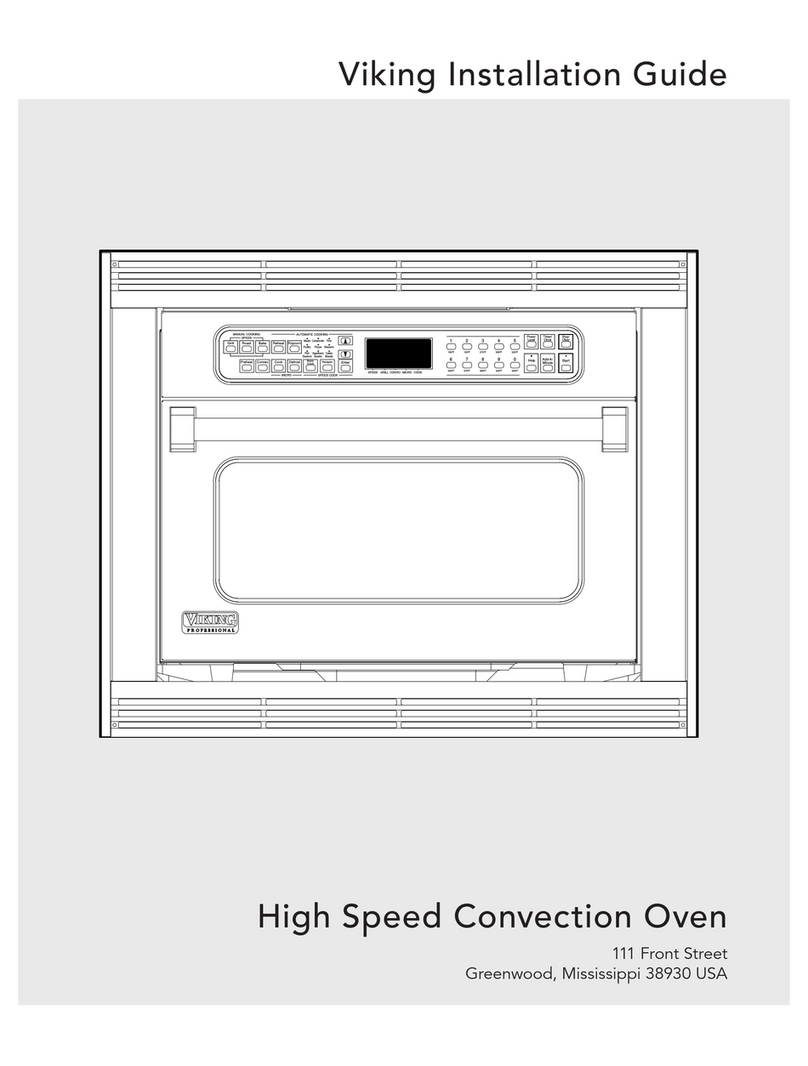
Viking
Viking Professional VHSO205 User manual

Viking
Viking F20517 User manual
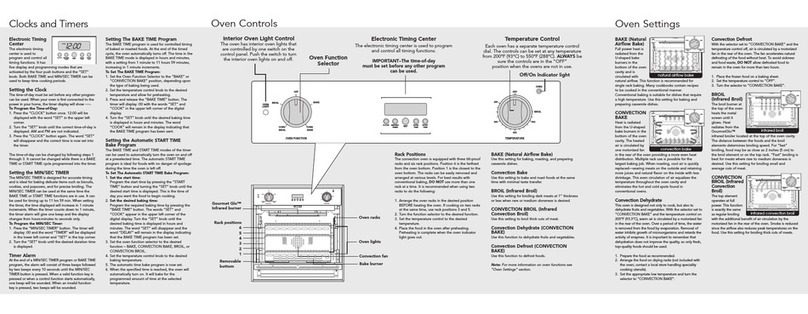
Viking
Viking Professional VGSO100 User manual

Viking
Viking DCSO User manual
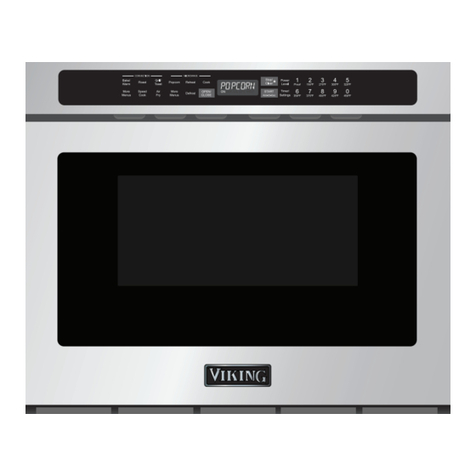
Viking
Viking DrawerMicro VMODC5240SS User manual

Viking
Viking DCSO244 Series User manual
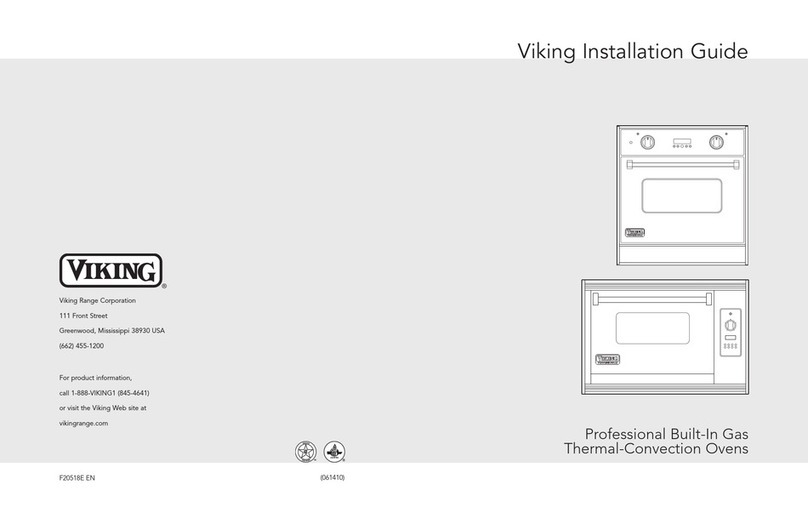
Viking
Viking Professional VGSO100 User manual

Viking
Viking F20516 User manual

Viking
Viking F20303 Instruction and safety manual
